Search Posts
Recent Posts
- Vinny Paz to be inducted TODAY into the International Boxing Hall of Fame – CES Boxing June 7, 2025
- In the News… quick recap of the week’s news (6.7.25) June 7, 2025
- Burn with Kearns: Strong without the spend: How scraps became strength tools – Kevin Kearns June 7, 2025
- Rhode Island Weather for June 7, 2025 – Jack Donnelly June 7, 2025
- How to advocate for threatened properties: The Heritage Alliance of Pawtucket June 7, 2025
Categories
Subscribe!
Thanks for subscribing! Please check your email for further instructions.
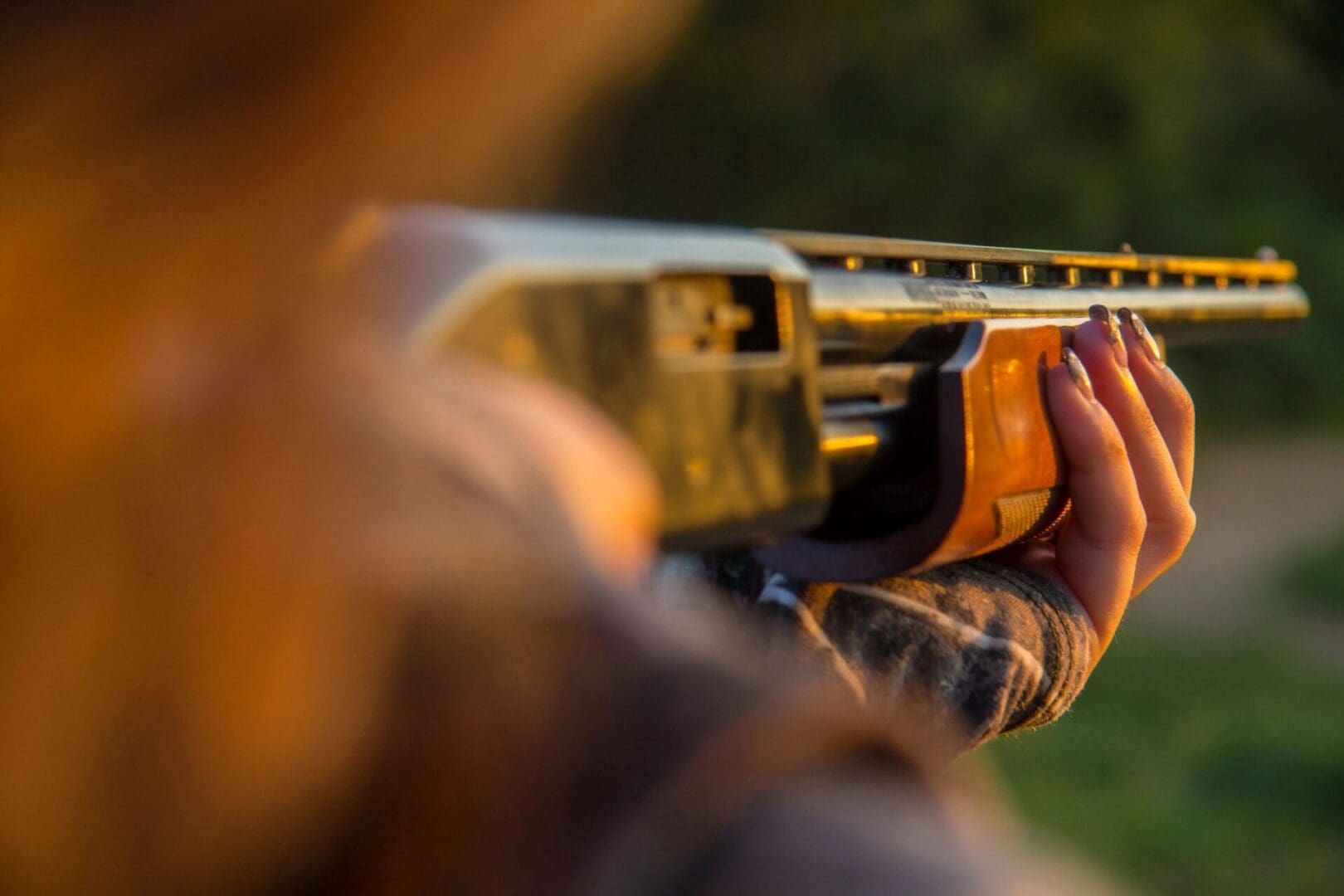
Outdoors in RI: Seafood Month, Ladies Fly-Fishing, Muzzleloader training, Pheasants, 2A, ghost guns
Seafood Month
With Governor Dan McKee proclaiming October as Seafood Month in accordance with National Seafood Month, the Rhode Island Department of Environmental Management (DEM), and the Rhode Island Seafood Marketing Collaborative are inviting the public to celebrate Rhode Island’s abundance of fresh and delicious local seafood by using the many tools and resources at SeafoodRI.gov to learn more about where you can buy it locally. The RI Seafood brand’s local seafood finder lists more than 118 restaurants, seafood markets, grocers, and direct sellers that offer local seafood, up-to-date landing data, an upcoming events calendar, easy and versatile recipes, and tips for how to cook and enjoy it. When choosing RI seafood, consumers are supporting RI’s seafood industry, local food system, and food economy.
“Making it easier for people to find and buy Rhode Island seafood is good for everyone,” said Governor Dan McKee. “It supports the thousands of hard-working men and women of one of the Ocean State’s oldest industries, celebrates the restaurants and seafood dealers and food businesses that have made Rhode Island such a ‘foodie’ destination, and ensures a steady supply of fresh, healthy, locally caught seafood, which is a cornerstone of our state food security strategy.”
“From calamari to oysters to various species of finfish, Rhode Island seafood is already known around the world; what we’re trying to do is jolt interest in and demand for our seafood right here in Rhode Island,” said DEM Director Terry Gray. “Through the efforts of the RI Seafood Marketing Collaborative, DEM aims to aid in connecting consumers to local seafood. There is an abundance of seafood that can be found year-round, and it is all delicious.”
“Fresh seafood is one of the many perks of life in the Ocean State, and the people and businesses who fish, catch, farm, process, deliver, sell, cook, and serve it are an integral part of the state’s economy,” said Molly Moran-Ogren, Chair of the RI Seafood Marketing Collaborative. “Every time you choose RI Seafood at local markets, restaurants, or by buying directly from the fishers themselves, you’re helping support the livelihoods of thousands of Rhode Islanders and a stronger, more resilient local food system.”
Established by the Rhode Island General Assembly in 2011, the Rhode Island Seafood Marketing Collaborative is a public-private body that aims to support local fishers and seafood farmers and increase awareness and consumption of locally harvested species by the public. Its membership includes representatives from all key sectors of the commercial fishing, aquaculture, and seafood industries joined by representatives from URI, RI Sea Grant, and state agencies including DEM, which chairs the group, and the RI Commerce Corporation, Rhode Island Department of Health, and RI Coastal Resources Management Council. The trademarked RI Seafood brand logo, which signifies that the products that bear the logo are locally landed or grown, is a core component of the Collaborative’s efforts to support local fishers and small businesses and to increase awareness and consumption by the public of locally fished species.
Over the past year, the RI Seafood brand has attended more than 27 events, interacted with over 3,200 consumers, engaged over 118 Rhode Island businesses, including fishers, aquaculturists, and other seafood venues in the RI Seafood Marketing campaign, all of which can be found on the local seafood finder map. RI Seafood offers small business support, like a Pilot Commercial Fishing Microgrant Program, and attendance at the Seafood Expo North America (SENA). Seafood consumers can subscribe for monthly emails which contain recipes, seafood partner highlights, upcoming events, information on what is in season, and more.
The fishing and seafood sector is a vital catalyst for Rhode Island’s economy that energizes shoreside and other businesses and adds value throughout the supply and demand chains, with the economic impact of Rhode Island fisheries and seafood totaling nearly 9,342 jobs and $872 million in 2022 according to NOAA Fisheries. The commercial fishing industry continues to rebound strongly from the challenges posed by the COVID pandemic, with 2023 commercial total pounds landed valued at $81.7 million, up by 9.5% over 2020 landings (ex-vessel), according to DEM’s Division of Marine Fisheries.
Follow RI Seafood on Facebook or Instagram (@RI.seafood) for regular updates. Sellers of RI seafood interested in joining the RI Seafood Marketing Campaign can sign up on the RI Seafood website.
___
Fly Fishing Clinic for Women
The Rhode Island Chapter of Trout Unlimited, in conjunction with South Kingstown Land Trust, is sponsoring a Fly Fishing Clinic for Women with Sheila Hassan of Cast90, a Fly Fishers Intl. Master Casting Instructor.

The event will be held on Saturday, October 19, 2024 (rain date Sunday, October 20), from 8:30 AM to 4:00 PM at South Kingstown Land Trust Barn, 17 Matunuck Beach Road, in Wakefield.
You will learn:
- An overview of Fly Fishing Rods, Reels and Lines
- Essential Fly Fishing Knots and Terminology
- How to make a Roll Cast and Basic Cast
- False casting and shooting line
Cost: $25.00 per person which includes lunch
All instruction and casting will take place on the grass at the SKLT Barn. All necessary equipment will be provided by RITU. Lunch will be inside. There will be a fly tying demonstration by United Fly Tyers of Rhode Island.
Register: This clinic is limited to twenty women. REGISTER BY OCT. 16th
Register using the form below or email Susan Estabrook at susan@ysrinc.com and please put “Women’s Clinic” in subject line.
https://secure.etransfer.com/EFT/blockcodeEvent_v2/payment1.cfm?d2org=RICTU&d2tool=WomensClinic
___
Muzzleloader Sight-In & Support Day
Muzzleloader deer season is approaching fast. Don’t get caught unprepared, whether it’s your first season or you’re a seasoned pro.
Join RI DEM’s Hunter Education staff at the Great Swamp Shooting Range for a morning of muzzleloader shooting support and basic information. The event will be held on October 19th from 9am to noon at GSSR: 277 Great Neck Rd. in West Kingston.

Sight-in your hunting muzzleloaders, bring out the reproductions, or show off your true black-powder antiques. Staff will have a limited quantity of muzzleloaders and instructors on-hand to offer one-on-one instruction on a first-come, first-serve basis to anyone interested.
No permit will be required for this special session, but non-permitted users will be limited to firing muzzleloading firearms only and be required to sign a waiver.
For questions, please contact Range Supervisor Branton Elleman at branton.elleman.ctr@dem.ri.gov, or 401-575-6331.
How do Muzzleloaders differ from regular firearms?
From Hunter-Ed:
Comparing Muzzleloaders to Conventional Firearms
To appreciate the role that primitive hunting plays in wildlife management, you first must understand how primitive hunting equipment, such as the muzzleloader, differs from conventional modern firearms.
- The speed at which a projectile travels (velocity) is slower in the muzzleloading firearm.
- Slower velocity reduces the muzzleloader’s effective hunting range to 100 yards or less, while conventional rifles can take game at 200 or more yards.
- The muzzleloader fires large, heavy projectiles that have a reduced trajectory, making shot placement more difficult.
- Because the muzzleloader projectile is heavier than a centerfire bullet, it can have a greater momentum than a typical centerfire bullet.
- The practical logistics of loading and firing are much slower, reducing the number of shots that can be taken. Shooting a blackpowder cartridge rifle can reduce the time lost in the traditional loading process, although velocity is not improved.
- Because of these factors, a muzzleloader hunter must fire from a closer range. Not only is greater marksmanship required for success, but the hunter also needs good still hunting, stalking, or tracking skills to get within an effective firing range of the game. Otherwise, the shot may not result in a clean kill—and wounding game is a risk that a responsible hunter will never take.
- As a result, muzzleloaders can be said to be less efficient than modern conventional firearms. A defining characteristic of the muzzleloader is its reduced efficiency as a firearm.
- Not only does muzzleloader hunting offer a greater challenge for the hunter, but it also gives the wildlife manager another way to manage the wildlife population while allowing hunters greater access to hunting opportunities.
___
Pheasant Stocking Begins this Weekend for Public Hunting on Management Areas
RIDEM will begin stocking pheasants this week for the 2024-2025 hunting season. DEM stocks pheasants to provide public hunting opportunities on select management areas throughout Rhode Island. After the youth weekend of October 12-13, stocking occurs twice weekly at most locations October 19 until early December and once weekly through the end of December, depending on weather. Hunters can check DEM’s pheasant stocking webpage for timely updates on stocking locations.
The 2024-2025 pheasant hunting season runs Oct. 19, 2024, through Feb. 28, 2025, with a daily bag limit of two birds. Hunters 15 and older must be in possession of a RI hunting license and game bird permit. Youth hunters 12 to 14 must have a junior hunting license and a game bird permit and be in the immediate company of a fully licensed adult 21 and older. A full list of pheasant hunting rules and regulations can be found in the Rhode Island Hunting and Trapping 2024-2025 Regulation Guide. Hunting licenses can be purchased online on DEM’S Rhode Island Outdoors (RIO) portal. Weather permitting, the 2024-2025 pheasant stocking will be conducted overnight to be first available on:
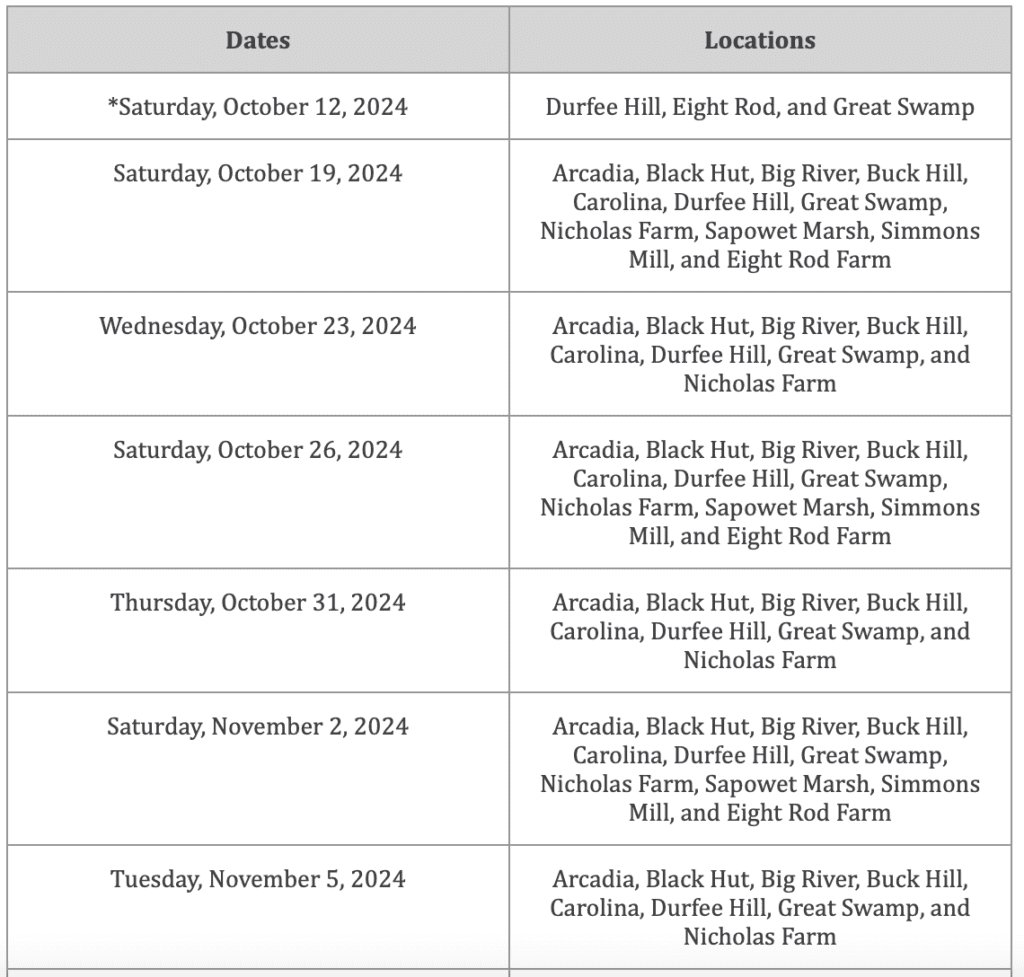
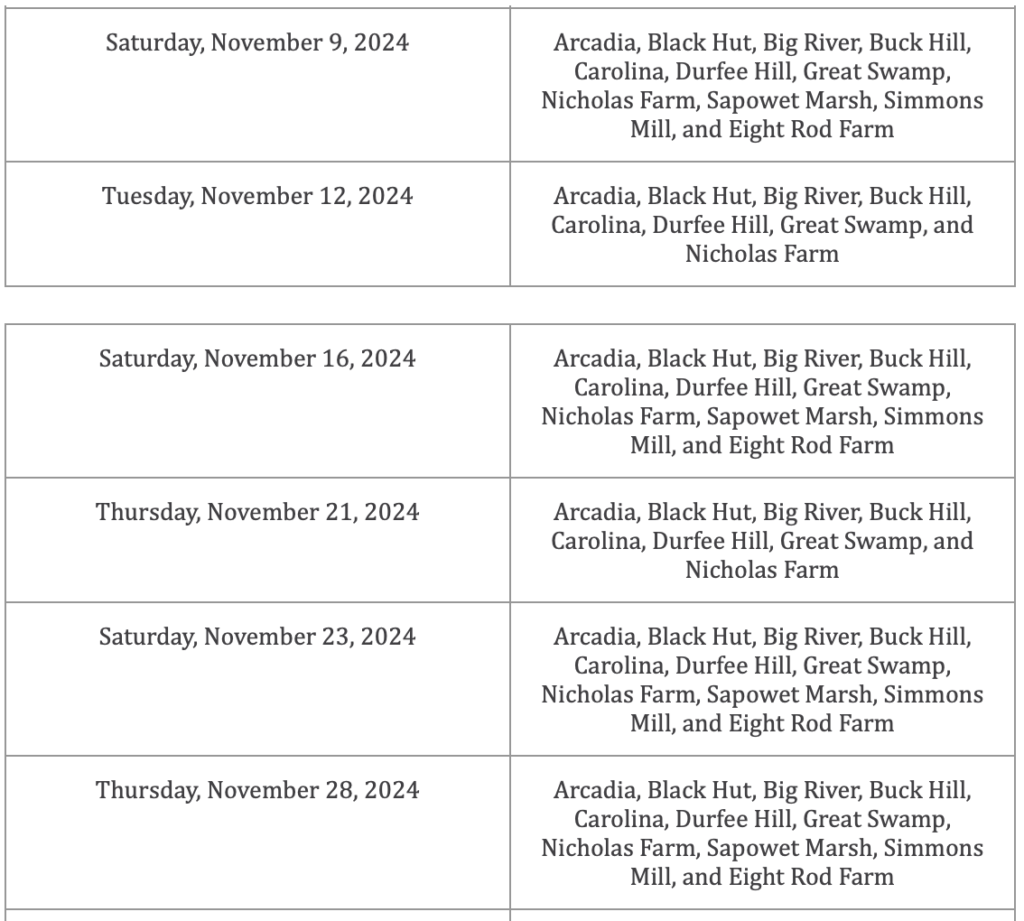
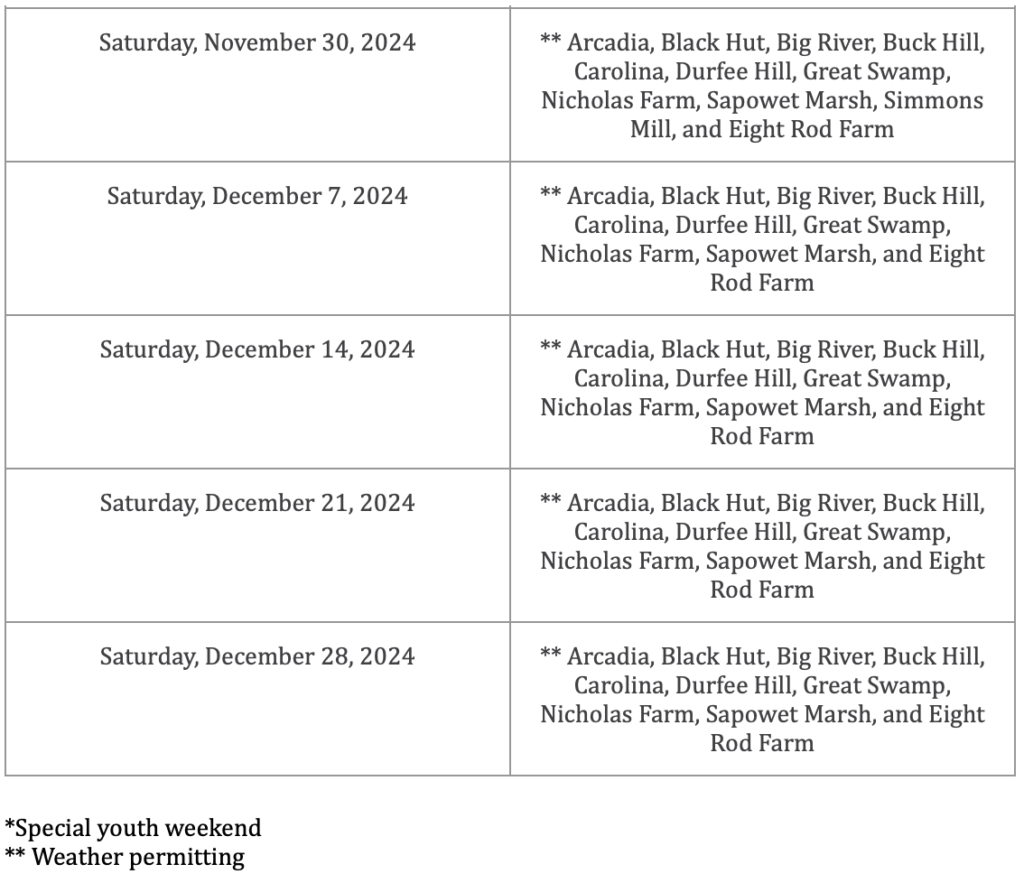
Upon the release and establishment of pheasants in North America in 1857, pheasant hunting has a long tradition in Rhode Island, supporting family customs, connecting people with nature, and attracting tourism to the state. Changing farming practices and land uses resulted in the elimination of pheasants from most of Rhode Island, except for a small population on Block Island. Although the landscape has changed, DEM’s pheasant stocking program continues to support Rhode Island’s pheasant hunting tradition. DEM supports pheasant hunting through DEM’s Division of Fish and Wildlife’s Hunter Education Program.
Safety training is required by law in Rhode Island for beginner hunters and to date, more than 40,000 people have completed a hunter safety course, helping to reduce related accidents in the state and elsewhere. A complete schedule of hunter educational offerings is available online here. Hunters provide funding for wildlife conservation through their purchase of firearms and ammunition through the Wildlife and Sportfish Restoration Program, and through the purchase of their state hunting licenses and permits. These funds are distributed to each state by the federal government and used to conserve land, manage habitat, restore wildlife populations, and much more.
In 2023 alone, Rhode Island received $7,176,940 in funding for wildlife restoration from this program. With the help of hunters, DEM has protected thousands of acres for wildlife in RI, continued research and monitoring efforts for both game and non-game birds and mammals, established a strong research partnership with University of Rhode Island, and continue to provide hunter education and wildlife outreach opportunities for the public. Without the contribution of legal and responsible hunters, DEM would not be able to conserve and protect our state’s wildlife.
___
WEAR YOUR ORANGE!
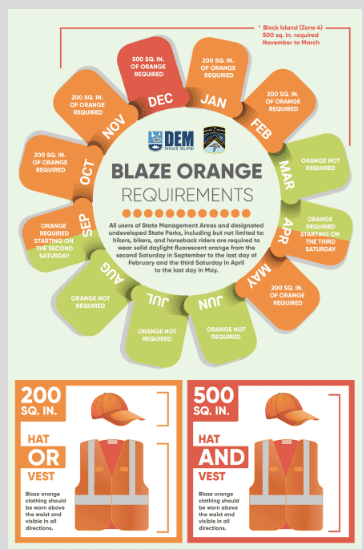
REMINDER: All users of Wildlife Management Areas and Undeveloped State Parks are required to wear at least 200 square inches of solid, fluorescent orange during the hunting season from the second Saturday in September until the end of May. Covering or clothing consisting of 500 square inches of blaze orange is required during the shotgun deer season in December. For more details, visit www.dem.ri.gov/orange.
___
2A update
Kamala Harris’ Glock
Kamala Harris, candidate for President, said during an interview with Oprah Winfrey that if anyone tried to break into her house, “they’re going to get shot”. In other interviews, specifically one on 60 Minutes, she identified that gun as “a Glock”. When asked if she had ever shot it, she replied she had, “at a shooting range”. A California resident, most Glocks are not allowed for personal ownership with exceptions for older families of Glocks, or purchasing from law enforcement. Harris has a long history of activism on restricting gun rights, including leading a group to convince SCOTUS that you have no individual “right” to own a gun. Proposition H would have banned all guns in San Francisco (which was unconstitutional) – and a mandatory turn in of guns. Critics have said this is a political elitist position and seen as a way to win over moderate voters. But, let’s remember, her history of activism on extreme gun control – and rule by Executive Order – stands – and will resurface should she become President.
Ghost Guns & SCOTUS
(From TANGLE): This week, SCOTUS heard oral arguments in Garland v. VanDerStok, a case challenging a 2022 Biden administration rule that regulated unserialized firearms, also known as “ghost guns.” A group of firearms owners, gun rights groups and manufacturers challenged the rule, arguing that the Bureau of Alcohol, Tobacco, Firearms and Explosives (ATF) exceeded its authority in issuing the regulation. During arguments, a majority of justices on the court seemed skeptical of the plaintiffs’ case, indicating that they would uphold the rule when they issue their decision in summer 2025.
Now, someone can buy a “gun kit” and with a drill and about 30 minutes, have a fully functioning firearm free of the rules, regulations, and restrictions that already exist for other guns. Saying that, if SCOTUS allows ATF to regulate ghost guns the same as is in place for all other firearms, it seems reasonable.
